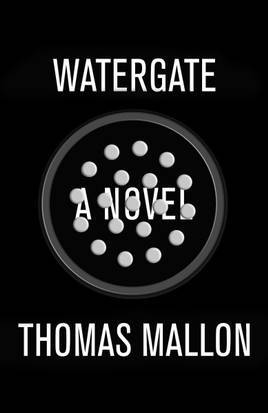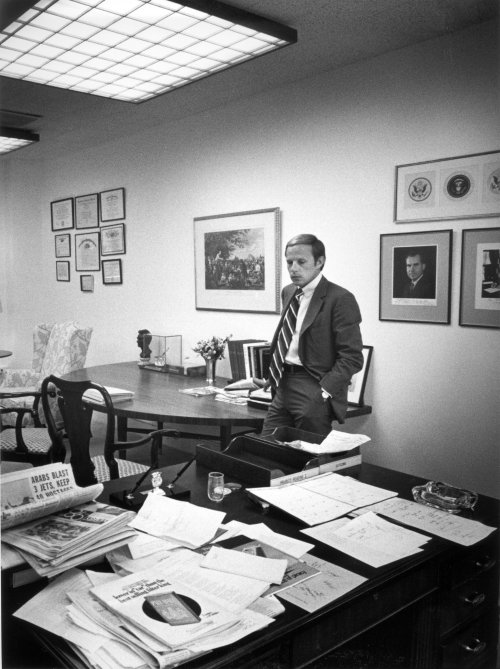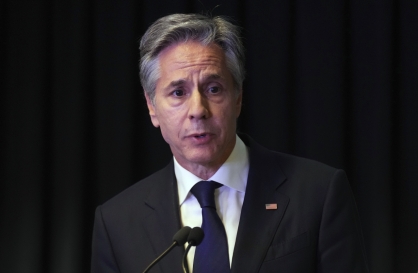Even the biggest secrets have secrets lurking behind them.
And, Thomas Mallon suggests in his absorbing new novel “Watergate,” America’s biggest and dirtiest revealed secret was no exception.
The 30th anniversary of the break-in at Democratic National Committee headquarters in the Watergate Hotel is this June, and for many Americans, the cover-up and scandal that followed has become both a time marker and trivia.
But the drama that led to the first and only resignation of a sitting U.S. president was built on questions that, at the time, seemed unanswerable. What did President Richard Nixon know, and when did he know it? How far did the conspiracy reach? How did “a third-rate burglary” (as Nixon’s press secretary Ronald Ziegler dismissed it initially) bring down the leader of the free world?
 |
“Watergate” by Thomas Mallon |
 |
John Dean, Richard Nixon’s White House counsel, works in the White House in 1971. Fred Maroon’s photographs of the Nixon White House are on display at the Smithsonian’s Museum of American History to mark the 25th anniversary of Nixon’s resignation Aug. 9. (MCT) |
“Watergate” doesn’t set out to answer any of those questions, although it gets around to many of them.
Instead, Mallon takes you inside the inner circles of the Nixon White House and the Committee to Re-Elect the President (known soon after by the best acronym ever, CREEP) to explore what it’s like to be on a Titanic built not of steel and rivets but of people and their pasts, on the surface unsinkable but in fact vulnerable in unseen ways.
In the novel, many of the players involved the Watergate affair or on its sidelines have things in their lives they’re desperate to hide that have nothing to do with re-election shenanigans.
Fred LaRue, a Mississippi Republican who serves as a soft-spoken fixer for Nixon’s campaign, lives with a dark mystery: his role in the years-ago death of his father, who was shot while the pair were on a hunting trip. Rose Mary Woods, Nixon’s loyal secretary, so resents the way she’s treated by top presidential aide Bob Haldeman that she alters evidence ― and, possibly, the course of history. Pat Nixon, the seemingly stiff first lady, keeps hidden a sense of humor and a secret past. Alice Roosevelt Longworth, Washington doyenne and daughter of President Theodore Roosevelt, plays the role of no-punches-pulled adviser to Nixon, whether he’s actually listening or not, thanks to a private bond they share.
While a number of the key events in the Watergate chronology are part of “Watergate,” Mallon just as often skirts past them, building up to them in one chapter and then skipping ahead to their aftermath in the next. (Advance knowledge of the players and events in the scandal, while not essential, makes keeping up with the story’s sweep a little easier.)
The result is not so much a history of Watergate as it is an integration of the event into personal and political history.
“Watergate” is Mallon’s eighth novel, and like most of its predecessors, is historical fiction. In his acknowledgments, Mallon writes, “The text contains deviations from fact that some readers will regard as unpardonable and others will deem unworthy of notice” But unlike most of his past novels ― bestsellers such as “Dewey Defeats Truman,” set in Republican Thomas Dewey’s Michigan hometown in 1948, and “Bandbox,” about a New York magazine in the 1920s ― nearly all of the characters in “Watergate” existed.
Perhaps the reason Mallon draws so much from actual events is that, as for many Americans who came of age politically during the late 1960s and early 1970s, Watergate remains a touchstone for him. In Mallon’s first novel, “Arts and Sciences” (1988), set on a college campus during the televised Watergate hearings, the scandal hangs over the proceedings like a bad joke that no one could get enough of: “... It was comedy for them, just as it was for the rest of the country, an amusing slapstick interlude after a decade of Roman tragedy. There was only a little leftover indigestion and high-mindedness. ...”
In “Watergate,” however, it’s no laughing matter. It’s a slip-up magnified by inattention to detail, coincidence, subconscious betrayals and old scars that still won’t heal. Mallon’s elliptical approach to the narrative gives each step of the deepening crisis a coulda-woulda-shoulda vibe, with decisiveness replaced by regret at actions taken and not taken.
In that setting, the women in Mallon’s story come out strongest, and most compelling. Pat Nixon ― also the subject of Ann Beattie’s recent novel, “Mrs. Nixon: A Novelist Imagines a Life” ― has a clear perspective on the scandal, how her husband’s actions played into it, and how she’s going to rise above it. Woods’ involvement in the famous “18-minute gap” incident ― in which, in real life, she unintentionally erased 18 minutes of a key White House tape recording ― is given layers of complexity, as her role in the Nixon White House gains an added patina of power and principle.
The men of “Watergate,” on the other hand, don’t seem capable of keeping on course, leaving the sinking ship of the Nixon presidency to founder on the wreckage they have left behind.
John Mitchell, Nixon’s longtime ally and re-election chairman, is too distracted by his out-of-control wife, Martha, to rein in his underlings’ crazier schemes; Howard Hunt, the ex-CIA agent caught up in the break-in, alternates between elaborate plotting and stupid-criminal-tricks; LaRue ― one of the novel’s more captivating characters ― is distracted by the return of a former lover and the specter of his father’s death to be the voice of reason Nixon’s camp really needs.
Nixon, one of the book’s most thinly drawn characters, fights and refights old battles in his head, letting the lesser angels of his nature take precedence over his dreams of posterity.
Of course, that could all be to Mallon’s point: that tragedy, even on a national scale, is something that can happen to you when you’re busy making other plans.
By Chris Foran
(Milwaukee Journal Sentinel)
(MCT Information Services)





![[Weekender] How DDP emerged as an icon of Seoul](http://res.heraldm.com/phpwas/restmb_idxmake.php?idx=644&simg=/content/image/2024/04/25/20240425050915_0.jpg)


![[Music in drama] An ode to childhood trauma](http://res.heraldm.com/phpwas/restmb_idxmake.php?idx=644&simg=/content/image/2024/04/25/20240425050929_0.jpg)
